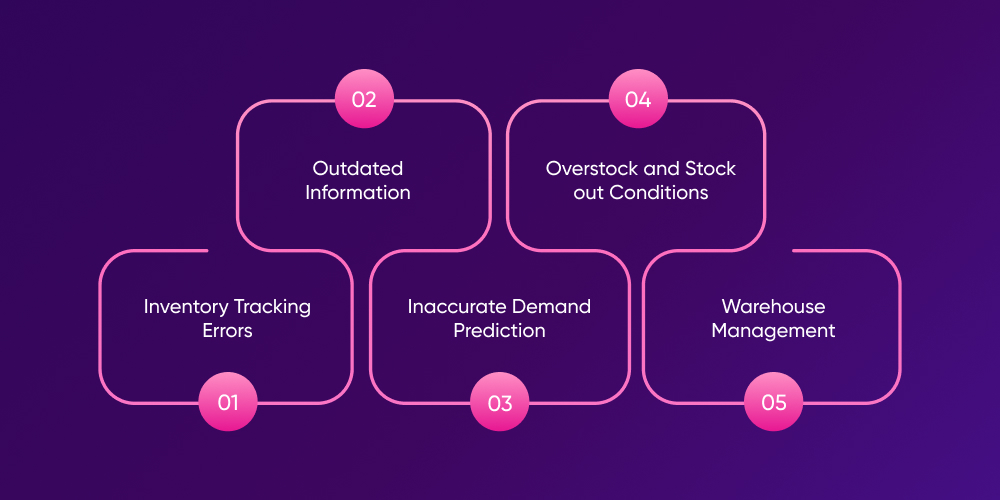How AI And IoT Is Used In Inventory Management And Supply Chain
Ditstek Blogs
The inventory management has come a long way from conventional processes to using advanced technologies like artificial intelligence and Internet of Things. Traditional methods used for inventory management relied on manual logbooks and periodic stock updates. Today, ways to manage inventory have changed a lot and moved to modern methods like using computer systems and smart technologies like AI and IoT.
The demand for accurate, efficient and scalable inventory management systems is increasing continuously. AI and IoT technologies are transforming inventory management by bringing in automation, accuracy and real time visibility to replace conventional methods and processes.
In this blog, we will explain how AI and IoT is used in inventory management to address the challenges businesses face with conventional methods. Also, you will know how these technologies make inventory management more accurate and efficient.
Your Freight’s Got a New AI Assistant!
DITS builds AI-driven logistics solutions that optimize routing, prevent delays, and make real-time decisions faster than any human ever could.
What is Inventory management?
Inventory management is the process of controlling and managing the inventory levels of a business. It involves managing the flow of goods from raw material to finished products. In addition, it also involves tasks like order processing, storing and selling of products. Overall, the aim of inventory management is to maintain sufficient stock so that customer demand can be fulfilled and costs can be minimized.
Here are some key aspects of inventory management:

- Inventory tracking: It involves keeping record of stock levels and movement of goods within the supply chain.
- Demand forecasting: It involves predicting the future sales to optimize stock levels.
- Optimizing costs: Optimizing the costs involves minimization of expenses related to ordering, holding and stocking goods.
- Meeting customer demand: Maintaining adequate stock to fulfil orders and prevent stock outs.
- Managing supply chain: This is done by coordinating with suppliers and logistics providers to ensure that goods are delivered in the right time.
Challenges in Traditional Inventory Management

Businesses face multiple challenges in managing inventory that impact efficiency, profitability and customer satisfaction. Here are some common challenges that businesses face while managing inventory.
Inventory Tracking Errors
When employees move items in a warehouse manually, they may forget to scan or log their location updates. In worst cases, they may not do it at the right time, which leads to phantom situations in which items appear as available, but actually they are not. The items may be misplaced or present in a wrong location. Such errors can disrupt the entire supply chain, which further leads to inaccurate stock levels, wasted money and delays in order fulfillment.
Outdated Information
Sometimes the recorded stock levels and real levels can be different, since traditional inventory systems sometimes rely on human updates. Inaccurate inventory counts, postponed restocking, and a restricted understanding of inventory can all arise from a lack of real-time visibility. For example, due to lack of real time data on how rapidly parts are used for production, a manufacturing company can unintentionally run out of them. This results in lost sales, unhappy customers, and delays in delivery of finished goods.
Inaccurate Demand Prediction
Demand forecasting can be challenging, but it's essential for managing inventory. It is affected by a number of factors, including promotions and seasonal trends. Changing customer tastes also play a role. Forecasts that are based exclusively on historical sales data can be sometimes inaccurate.
Overstock and Stock out Conditions
Stock outs can result in missed sales, irate customers, and possible harm to a brand's reputation. Especially for seasonal or perishable goods that might later need to be thrown out or discounted, overstocking raises holding costs and locks up cash. Thus, maintaining a balance in stock levels is a crucial aspect of inventory control.
Warehouse Management
Another challenge is regulating the flow of goods and making the most of storage space. Overstocking, lost materials, and disarray brought on by ineffective storage can result in delays and higher operating expenses. Inefficient warehouse architecture and labor-intensive, slow manual operations can reduce worker productivity.
Stop Counting Boxes: Let Smart Sensors Do the Math!
DITS integrates AI and IoT into inventory management so your shelves talk, track, and restock themselves almost like magic (but it's tech).
How Can Businesses Use AI for Better Inventory Management?
Nowadays, AI is being used in almost every industry to leverage its benefits, and inventory management is not an exception. AI in inventory management is the practice of using AI technologies to automate and optimize the inventory in any company. AI offers several improvements for conventional methods of inventory management using data analysis, predictive analysis and machine learning. Using these processes, AI can optimize most of the conventional tasks such as demand forecasting, supplier management and replenishment of stock.
The use of AI in inventory management offers multiple advantages like improved accuracy, cost savings, and high levels of customer satisfaction. These benefits make AI an essential component of the current supply chain strategies used by logistics and supply chain businesses.
How Can Businesses Use AI for Better Inventory Management?
IoT stands for Internet of Things, and in inventory management, it refers to the integration of IoT devices to manage and monitor inventory in real time. Some examples of IoT devices include RFID tags, GPS trackers, temperature and motion sensors. These systems collect and share data, track stock levels, and supply chain movements automatically.
For example, RFID tags and barcode scanners can track the quantity and movement of goods across warehouses. Temperature sensors can monitor products and conditions in refrigerated storage. Such a flow of data and information offer you real time visibility into the state of inventory.
IoT is important for addressing challenges that businesses face with traditional methods of inventory management. Challenges such as manual errors, lack of real time visibility and inefficiency are common and IoT addresses them with precision. IoT can offer real time monitoring of inventory, improve efficiency using automation, and helps inventory managers prevent overstocking and understocking.
Key Applications: How AI and IoT are Used in Inventory Management

This section highlights how AI and IoT are used in inventory management to optimize processes and save time, costs and resources. From dependable manual processes which often yield wrong estimations to efficient, accurate, and agile information, AI and IoT have completely transformed the ways of inventory management.
Immediate Inventory Tracking and Visibility
Immediate inventory tracking means you know the exact amount of goods or items you have in the stock, where they are placed, and their status at any moment. It is typically done through scheduled manual counts, which are time-consuming and prone to errors. IoT devices do an entirely different work by giving continuous data streams which lets you know the current status of inventory with its present location in a warehouse or storage space.
How IoT Enables Instant Tracking and Visibility
- RFID (Radio-Frequency Identification) Tags: Small yet cheap tags are attached either to the item or pallet that are wirelessly read by the RFID readers usually positioned strategically throughout warehouses, stores, and along the supply chain. It provides real-time tracking of the continuous movement of an item.
- Sensors: Various types of sensors (for example, temperature, humidity, and motion) are attached to inventory or storage locations to monitor environmental conditions vital to specific goods (like pharmaceuticals or food). Satellite location sensors (GPS, Bluetooth beacons) can track the precise location of assets in a facility as well as during the transportation of products.
- Smart Shelves: Smart shelves are equipped with weight sensors or RFID readers, and they are automatically updated when items are put on or removed from them, which provides real-time status of the actual stock levels on shelf.
- Drones: Autonomous drones are equipped with cameras and RFID readers that allow them to scan entire warehouses for misplaced items or with the aim for verifying inventory counts, which minimize the need for human audits.
How AI Optimizes Inventory Tracking and Visibility
- Data Accumulation and Integration: These platforms gather all the data generated by these devices into one common portal with AI running into it.
- Real-time Dashboards and Visualizations: This complex data can be seen in a dashboard in a visualization form that lets managers view the current stock levels, location of items, and movement pattern at a glance.
- Alerts and Notifications: AI continuously monitors inventory conditions. When real-time data shows that a parameter (like temperature, humidity, or stock level) drops below the set threshold, the system sends instant alerts like flagging misplaced items or quality issues before they escalate.
- Anomaly Detection: AI algorithms can discover out-of-the-ordinary patterns in the movement or level of stocks. They are meant for detecting errors, thefts, or other issues that might need further investigations.
Demand Forecasting and Predictive Analytics
Accurately forecasting demand for the future is among the most important inputs necessary to stock the correct amount of inventory. Too much stock closes up capital and can rot, too little may lead to lost sales and dissatisfied customers. AI uses historical data and some other factors to provide more accurate demand forecasts.
How IoT Handles Forecasting and Predictive Analytics
- Point-of-Sale (POS) Data: Not strictly an example of new IoT, the modern POS systems are able to generate real-time sales data. This is an important input into demand forecasting.
- Sensor Data for Product Usage: IoT sensors track actual usage patterns for certain products (connected appliances, industrial equipment) to be able to develop valuable insights on the rate of consumption of goods.
- Environmental Sensors: Weather patterns can be integrated in demand forecasting models, by the data collected on these patterns by IoT sensors or APIs available publicly. Weather conditions significantly affects the variations of demand for many products
- Social Media and Online Activity: Not direct inventory sensors, scraping data off social media websites and online search activity can give an indication of consumer interest and thus forecast demand.
How AI Powers Forecasting and Predictive Analytics
- Machine Learning Algorithms: Analyzing the given historical sales data, time series analysis, regression analysis, and neural networks, devise AI algorithms that can reveal seasonal trends, promotional activity, economic indicators, and even social media sentiment. They help in identifying patterns and forecasting future demand with more precision than simple statistical methods.
- Predictive Modeling: Through numerous variable considerations, developing forecasts with different demand scenarios becomes possible for companies as AI builds sophisticated predictive models.
- Scenario Planning: Ultimately, AI can help businesses run simulations on probable demand scenarios with various assumptions to prepare reeling possibilities.
Automated In-Store Replenishment
In this approach, the AI helps in stock-reordering operations based on real-time inventory and demand forecasts that would minimize manual intervention and just-in-time stock replenishment. Both industrial license and IoT enable the process.
How Does IoT Help
- Warning sign for low stock level: Smart shelves equipped with IoT sensors detect when inventory levels drop below a predefined threshold. This data is instantly sent to an AI-powered inventory management system, which can automatically trigger restocking actions or alerts.
How Does AI Help
- Intelligent Setting of Reorder Point: The dynamic determination of the reorder point entails various parameters, such as predicted demand, supplier lead time, safety stock levels, and even carrying costs, which are considered by an AI algorithm. Static reorder point calculations do not perform any of the above-mentioned variables.
- Automated generation of purchase orders: As stocks for an item reach the reorder point determined by AI, generated purchase orders can be automatically sent to suppliers.
- Supplier management optimization: Supplier performance, e.g., on lead times and reliability, is analyzed and supported for optimized supplier selection and purchasing quantities.
Warehouse Optimization and Management
This means that AI and IoT are transforming simple warehouses into highly efficient and data-driven operations.
How IoT Provides Visibility and Control
- Environmental Monitoring: Factors such as temperature and humidity and other environmental conditions vital to maintain the quality of goods stored are monitored through IoT sensors.
- Asset Tracking: Indoor positioning systems like GPS and RFID do track the location of forklifts, pallets, and all other equipment within the warehouse for improved utilization and faster search.
- Worker Wearables: Smartwatches and other wearables can do location and activity tracking of workers, thus providing data for workflows optimization and ensuring safety.
- Smart Lighting And Energy Management: Movement and systems of lighting and HVAC are automatically be adjusted by IoT sensors to save energy.
How AI Optimizes Operations
- Warehouse Layout Optimization: AI algorithms analyze prior movement data to point out future flows, so that the warehouse could be optimized efficiently, thus minimizing the travel distance.
- Optimized Picking Routes: AI could be the most effective means to calculate the movement of warehouse workers to pick items from orders, in the least time and effort possible
- Staff Allocation: AI can predict and analyze workload and worker availability to dynamically allocate tasks and optimally staff workers.
- AI-Powered Robots and Autonomous Vehicles: This includes the effect of AI algorithms on autonomous mobile robots (AMRs) and automated guided vehicles (AGVs), thus improving efficiency and helping to bring down wages by guiding these systems for task execution such as transporting goods, picking and checking inventories.
By now, we have discussed in detail, how AI and IoT is used in inventory management and hope you understand it clearly. With these key applications, we demonstrate how the combination of IoT's ability to gather real-time data with AI's ability to analyze and extract insights from that data creates a new era of intelligent and efficient inventory management with beneficial impacts across various business sectors.
Lost Inventory? We’ll Help You Hunt It Down With AI!
DITS uses AI and IoT to give you real-time visibility of your inventory, so you never lose a product or your patience again.
The Future of AI and IoT in Inventory Management

The integration of AI and IoT in inventory management is a rapidly evolving field with exciting possibilities. Here are some key trends and potential future applications:
- Predictive Maintenance of Warehouse Equipment: This will require IoT sensors to continuously monitor the health and performance level of warehouse equipment (e.g., robots, conveyors, refrigeration units). AI will analyze the outcomes and predict possible failures that would help in the proactive maintenance and thus minimize downtime.
- Expectations for Fully Autonomous Warehouses: The process of automation will further continue, as in the case of increased percentage of warehouse tasks, such as receiving, storage, picking, and packing, handled by the AI-powered robots and drones. These eventually lead to totally autonomous warehouses in which human intervention will be minimal or nil.
- Edge AI for Real-time Decision-Making: Processing data at the "edge" (i.e., actually on the IoT devices or nearby servers) instead of solely in the cloud will become more common. This will allow fast real-time analysis and decision-making, which is essential for time-critical activities like autonomous navigation or warning systems.
- Sustainable Inventory Management: Here, AI and IoT are focused on more sustainable inventory optimization. It is better for managing perishables and thus would translate into less spoilage; route optimization in transportation is concerned with a lower level of emissions; and another is tracking the environmental footprint of inventory across its entire lifecycle from production through use to disposal
- Human-Robot Collaboration: While automation will increase, humans will still play a vital role. The future will probably see more smooth collaboration between humans and robots, enabled with AI to assist human beings with complex tasks than handle repetitive or strenuous work on their behalf.
- Self-Optimizing Systems: AI algorithms will present their advancements in learning and adapting to dynamic real-time changes and will be able to lead toward developing self-optimizing inventory management systems with reduced manual intervention.
Conclusion
AI and IoT makes inventory management convenient by transforming traditional, manual procedures into intelligent, automated systems. Such technologies would have real-time visibility, improve accuracy and create predictive analytics that will lead to efficient use of resources so that they will surpass all barriers such as tracking errors, stock disparity, and uncertainty in demand.
Much equipment and hardware breakthroughs will come when AI and IoT improve further and the technology comes together while offering more new innovations like predictive maintenance, autonomous warehouses, and sustainable operations. Adoption of these smart technologies will lead to increased operational efficiency, customer satisfaction, and ensure profits over time.
At Ditstek Innovations (DITS), we specialize in custom AI software development and IoT software development tailored to modern inventory challenges. From real-time tracking to automated decision-making, we help businesses harness the full potential of these smart technologies.
FAQ’s
1. How AI and IoT improves inventory accuracy?
AI and IoT minimize human errors and data is immediately up-to-the-minute from IoT, as intelligent tag readers, sensors, and intelligent shelves keep track of the status and movements of the inventory. AI devices analyze patterns, spot anomalies, and predict future trends, assuring wise counsel on maintaining ideal stock levels. Discrepancies against the recorded and actual inventory would reduce, thus translating to better decision-making and operational smoothness.
2. What are the main advantages of AI and IoT in inventory management?
Among the likely advantages of AI and IoT integration in the field are immediate visibility, accurate demand forecasting, automated stock replenishment, and improvement in warehouse efficiency. Lessening or completely eliminating understock and overstock scenarios will obviously be helpful in operational cost reduction. AI can link all the big data with other data sources, which can then leverage optimization in order processing while IoT can automatically track and record every item movement.
3. Does AI and IoT help in decreasing costs in the inventory management cycle?
Yes, AI and IoT helps minimize inventory management cycle costs. They automate business processes that can preclude frequent manual checks, which can also reduce the losses made due to overstocking, spoilage, or misplacement. It optimizes the whole supply chain, forecasts demand accurately, and improves supplier coordination, thus saving money on inventory holding and procurement costs.
4. How do these technologies help in demand forecasting?
AI enhances demand forecasting by reviewing historical sales data, seasonal trends, market circumstances, and even social media activities. It helps identify patterns and anticipate future demand accurately using machine learning algorithms. At the same time, IoT presents real-time data from point-of-sale systems, sensors, and many others, further contextualizing AI models for accurate prediction. Both AI and IoT make it possible for businesses to make smarter decisions on scheduling and amount of restocking.
5. What are the common challenges in the implementation of AI and IoT technologies in inventory management?
Some of the common challenges encountered include cost of initial investment, infrastructural integration with already existing systems, security of data, and the training demands that come with such implementations. Businesses may also find it difficult to manage and analyze large volumes of information that would be generated through IoT devices. However, effective planning, support, and a phased approach to implementation will make it possible to address these challenges.
6. How AI and IoT Complement Each Other?
The natural synergy between AI and IoT makes this combination so powerful when both these technologies work together in inventory management. IoT provides data from multiple smart devices and AI transforms it into meaningful and actionable insights. This is how both AI and IoT complement each other and work simultaneously to offer multiple advantages.

Dinesh Thakur
21+ years of IT software development experience in different domains like Business Automation, Healthcare, Retail, Workflow automation, Transportation and logistics, Compliance, Risk Mitigation, POS, etc. Hands-on experience in dealing with overseas clients and providing them with an apt solution to their business needs.
Recent Posts
Get in touch










 Calgary | Edmonton | Vancouver | Toronto
Calgary | Edmonton | Vancouver | Toronto Marriott Downtown Hotel | Calgary
Marriott Downtown Hotel | Calgary